MC Review:
- Sponges are supported by a “skeleton” of…
- Choanocytes
- Spicules
- Spanx
- Cnidocytes
- Soft sponges have spicules made of…
- Calcium carbonate
- Silica
- Spongin
- None of the above
- Phagocytosis is the process of…
- Cells engulfing food
- Straining food from the water
- Injecting venom through nematocysts
- Asexual reproduction in sponges
- Which best describes sexual reproduction in sponges?
- Broadcast spawning with external fertilization
- Broadcast spawning with internal fertilization
- No sexual reproduction
- Use the following picture for questions 5 and 6.
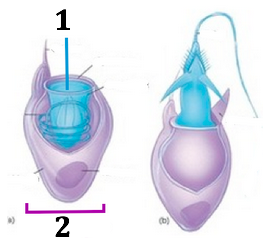
- What is the name of structure 1?
- Choanocyte
- Nematocyst
- Cnidocyte
- Choanocyst
- What is the name of structure 2?
- Choanocyte
- Nematocyst
- Cnidocyte
- Choanocyte
- Choanocytes are also known as?
- Stinging cells
- Nematocysts
- Sponges
- Collar cells
- Which characteristics help choanocytes catch food?
- Flagellum creates a current
- Sticky collar traps food
- Stinging cells stick into prey
- Both A and B
- Sea anemones spend the majority of the their lives in which body plan?
- Polyp
- Medusa
- Asymmetrical sponge
- The digestive system in cnidarians is describes as a…
- One-way digestive system
- Two-way digestive system
- Phagocytosis
- “True Jellyfish” are part of which cnidarian class?
- Class Anthozoa
- Class Cubozoa
- Class Scyphozoa
- Class HydrozoaPhylum
Phylum Porifera Review Questions (On note set 5-1)
1. Sponges function more like a colony of unicellular organisms despite being a single organism. Describe why this statement is true.
Each cell is responsible for their own feeding/excretion. No systems to transport gas, get rid of waste, or nutrition.
2. What three materials could make up the structure/”skeleton” of a sponge? What are these supports called?
The “Skeleton” is made of spicules. These spicules hold the pores open and allow filter feeding. They can be made of: Silica (glass), Calcium carbonate (chalk), or spongin (soft material).
3. Describe the feeding process of a sponge. Make sure to use the following vocabulary in your answer: spongocoel, choanocytes, phagocytosis.
1. Sponges are filter feeders. They pull water into the spongocoel (middle cavity of a sponge) through pores.
2. The spongocoel and canals are lined with choanocytes which have flagella (whip-like tails) which pull food inward. Choanocytes help catch food with their sticky collar that traps food and their flagellum, which pulls water into the sponge!
3. Food enters the cell through phagocytosis (Same as many unicellular organisms such as amoebas) Each cell is responsible for their own feeding.
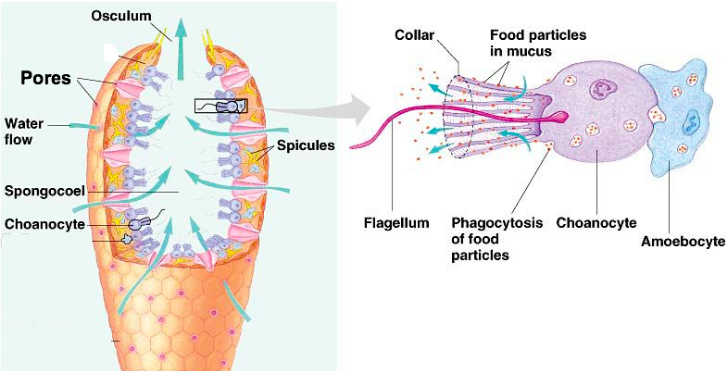
4. Why is sexual reproduction beneficial for sponges (or other organisms)?
Increases genetic diversity. Note sponges do broadcast spawning with internal fertilization.
5. When could asexual reproduction be beneficial?
When mates are not present or when the sponge is broken (fragmentation)
Phylum Cnidaria Review Questions (On note set 5-2)
-
What is the defining feature of cnidarians? (Hint: Think about their name and the type of cell they use to hunt)
Cnidocytes – Stinging cells located on the tentacles. Each cnidocyte has a loaded “harpoon” called a nematocyst inside.
2. Draw and label a diagram of the typical life cycle of a cnidarian. Include a medusa and a polyp phase. (Include the terms: strobilation, external fertilization, planula, medusa, and polyp)
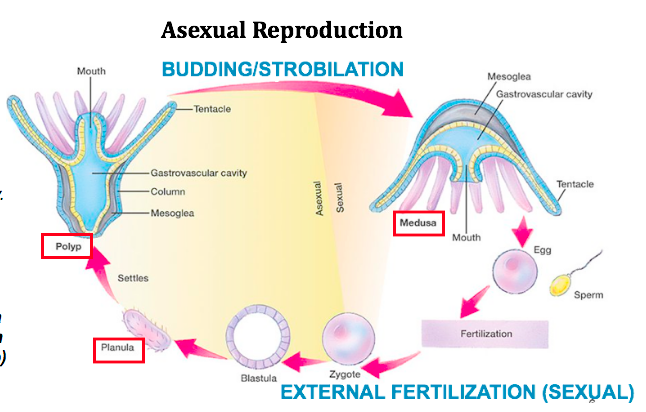
3. How many cell layers do cnidarians have? What are these called? What is in between them?
Two cell layers – Ectoderm, Endoderm.
- Ectoderm is the outside tissue layer
- Endoderm is the inside tissue layer
There is a jelly-like mesoglea between the two. This is not a tissue layer!
4. Describe a two-way digestive system found in cnidarians.
Food and waste exit from the same opening!
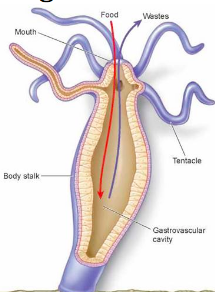
5. Compare sponges to cnidarians. What do they have in common? What differences?
Similarities:
- Both animals (Multicellular/heterotrophic)
- Broadcast spawning (mass release sperm/eggs into the environment)
- No specialized respiratory structures.
- Gas exchange through diffusion.
Differences:
- Cnidarians show radial symmetry. Sponges asymmetry.
- Each sponge cell eats through phagocytosis. Cnidarians have a gastrovascular cavity where prey is broken down.
- Sponges filter feed. Cnidarians are carnivores.
- Sponges – Internal fertilization. Cnidarians – External fertilization
6. Describe the complete feeding process in cnidarians (from catching to eating to getting rid of waste). Be sure to include as much detail as you can including the cells involved and their mechanism.
Tentacles are covered with special cells called cnidocytes. Inside each cnidocyte there is a spring-loaded spear called a nematocyst.
- The tentacle comes into contact with the prey. These tenacles surround the mouth in both medusa and polyp forms.
- Physical and chemical cues cause the nematocyst to shoot out of the cnidocyte and stick into the prey – delivering the venom and causing prey to be stuck.
- Tentacles contract, bringing the prey to the mouth.
- The prey enters the gastrovascular cavity and is digested with powerful enzymes.
- Waste exits the “mouth.” This is a two-way digestive system!
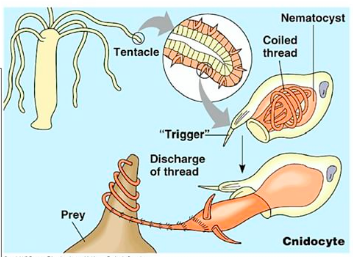
Comments by shaun pletsch